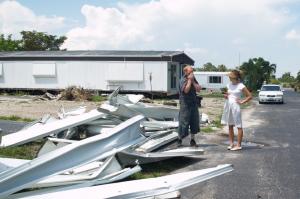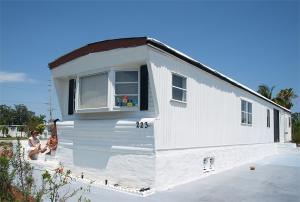Five questions for Esther Sullivan
A year after Esther Sullivan graduated from the University of Chicago – an English major and a produced playwright – Hurricane Katrina ravaged New Orleans. Sullivan volunteered with humanitarian organizations working in the city, “sleeping on a cot in a gutted elementary school and working to clear out people’s flooded homes.”
During and after the hurricane, Sullivan said, the key role of the built environment in producing broader social inequalities was evident. She had always been interested in the “complexities of the human experience, especially in the ways people are shaped by the cities they call home,” and her time in New Orleans “catalyzed my drive to investigate the interconnections between housing, community, urban regulation and social inequalities.” She went to the University of Texas at Austin where she earned a Ph.D. in urban sociology, studying interconnections from a sociological standpoint.
Afterward, she focused her job search on rapidly growing cities.

“As an urban sociologist, the city is the site of my research, but it’s also the inspiration for my future projects and a laboratory for my students. It was important for me to work at an urban-serving university, and since my research is positioned at the intersection of urban problems and the regulatory or governing strategies used to manage those problems, I was especially interested in working in a rapidly growing city that was also actively involved in addressing growth and change (for better or worse) at the municipal level.”
Last fall, she was offered an assistant professorship at CU Denver, and, she explained, it seemed the perfect fit.
“Denver is one of the fastest-growing areas in one of the fastest-growing states in the United States and is a city where there is a concern at the local level with actively planning for urban issues surrounding population growth and change.”
As Denver and Colorado grow, “social problems associated with the production and regulation of housing” also are growing.
“When processes like this intersect, the types of social issues that I study as an urban sociologist – issues such as housing security, fair housing access, eviction, and government sanctioned urban redevelopment – these issues come to the fore,” she said.
1. “Manufactured Insecurity: Mobile Home Park Evictions and Americans’ Tenuous Right to Place” is a current book project. First, what is the status of the book, and secondly, how did you gather your data?

I’ve spent the last six years studying poverty housing in the United States. Though little systematic research has been done on manufactured housing, more commonly called mobile homes or trailers, this mode of housing provides the single largest source of affordable housing in our nation. Simply put, mobile homes are a primary way we house the poor in the U.S. Currently almost 20 million Americans live in manufactured housing, 73 percent of them earning less than $50,000 per household per year. For many, mobile homes represent the American dream of homeownership at an attainable price. But manufactured housing occupies both a marginalized sector of the housing market and an almost completely ignored area of study in scholarship on housing, community and the contemporary U.S. city.
My book asks why. It investigates the social and spatial marginalization of the mobile home park and the social production of “trailer trash” as a class of residents. Specifically, it probes the issue of insecure housing in mobile home parks, where about half of all manufactured housing is located, and where residents own their homes but rent the lot under their homes. This form of divided land tenure puts residents at incredible risk as their communities are sold right from underneath them and homeowning residents are evicted en masse. These mass evictions occur so frequently that advocacy organizations have declared an “epidemic of closures.”
The book based on this research, “Manufactured Insecurity,” uses the case of the mobile home park to respond to a fundamental question relevant to social scientists and policymakers alike: How do the poor access and retain secure housing in the face of widespread poverty, deepening inequality and scarce legal protection? Because of my research interest in regulation and governance, I pay special attention to the state laws that attempt to manage these mass evictions and I explore how state housing regulations impact the experience of housing insecurity.
My research methods rely on a deeply immersive form of ethnography, which is a method of empirical study requiring extensive fieldwork embedded within a group or community. Ethnography has historically been used to examine individual experience through careful attention to the setting, culture and interactions of daily life, so it is an especially useful tool for understanding people’s lived experience within the context of the communities and cities they inhabit.
In my current book project as well as other projects, I pair ethnography with GIS technologies and geospatial analysis to map broader socio-spatial trends at the macro level before honing in on household-level experiences within affected communities. The book is based on a comprehensive mixed-method geospatial and ethnographic study conducted over the course of five years.
This background data offers context to an up-close ethnographic account of life within mobile home parks before, during and after they closed. Over two continuous years, in parks in Florida and Texas, I collected this data by living inside potentially closing mobile home parks in my own rented mobile home. The ethnography is based on the years of field work I conducted among 200 residents in 32 closing mobile home parks in Florida and Texas – two states exemplary of major national trends in both housing policy and poverty governance. In both states I was evicted with residents and thus my research not only captures a picture of communities before they are dismantled but also follows residents in their varying trajectories during and after eviction. It also compares the differing outcomes in each state, which have very different regulations for managing mobile home park closures.
2. What do you mean by “Americans’ ‘right’ to place,” which is part of the book title?
The right to housing is recognized in a number of international human rights documents including the Universal Declaration of Human Rights. Most developed nations affirm a basic human right to housing. This is not the case in the United States. The U.S. Constitution ensures many fundamental rights, but housing is not one of them.
Arguments in favor of a right to housing are straightforward. As housing scholars point out: Peoples’ homes are where they spend their most time; housing costs are often the largest household expenditure and thus the affordability of housing impacts peoples’ access to food, essentials, medical care and more; and the safety and security of housing has broader impacts on people’s access to quality schools, jobs and community services.
Thinking about housing in terms of a “right to place” positions not only stable housing but also stable communities within this rights-based framework. Recognizing a right to place allows scholars to take a more critical perspective on processes such as urban redevelopment, gentrification, displacement, etc. And to think about these processes in terms of a more fundamental human right to remain in the homes and communities people have created for themselves.
3. Denver recently broke ground for affordable housing units near the one-time Health Sciences Center. The mayor announced in 2013 a program that would develop or rehab affordable housing units over five years. At the same time, housing prices have risen by leaps and bounds. Are we doing enough to provide affordable housing for our citizens? Why or why not and what else can be done?
There are several important things happening right now in the city of Denver’s approach to housing. The city has announced it is ahead of target for the housing goals they set in 2013, reaching the goal of 3,000 new units of affordable housing a year early.
Also, this year Mayor Michael Hancock’s administration is setting up a permanent affordable housing fund that is pooled from a combination of property tax increases and fees on new development. This fund – estimated at $150 million dollars in the first 10 years – will be divided to fund programs targeting affordable rentals, homeownership, workforce housing and homelessness programs.
These are important developments that show the city acknowledges the central role of housing in the long-term stability of the city. However we are still experiencing a serious housing shortage at all levels, especially for affordable housing. This isn’t only true in Denver, but also across the state. Since 2012, the state is about 55,000 homes and apartments short of what it needs based on population growth, and Denver is experiencing a major housing crunch as it absorbs much of this population growth. HUD recently released a report showing that rents in Denver have grown by 65 percent, while median family incomes have only grown by 5 percent. This creates a real need for moderate and affordable housing options.
In this context, the political decisions over the type of housing we produce with affordable housing funds will become increasingly important. For instance, much of the city’s affordable housing fund will produce “workforce housing,” which is targeted at moderate-income housing and people making up to 80 percent of area median family income. Workforce housing is often far out of reach for lower income households and those on fixed incomes. It is not a possibility for the very poor and the homeless.
Decisions over what exactly we fund as affordable housing will shape the future of our city. Additionally, as these processes ramp up in Denver, it will become equally important to target housing stability, not only new housing production. It is counterproductive to produce new affordable housing when a large number of households are being forced out of their homes.
4. Another of your publications discusses sustainable housing applications for low- to moderate-income families, not just higher-income folks. What are some of those applications?
Sustainable residential construction and rehab often targets middle- and upper-income residential neighborhoods. However, in the United States, and in middle developing countries such as Brazil and Mexico, there is growing recognition that urban sustainability will only gain traction if widespread applications are also incorporated into the lower-income housing market, including in “informal communities” where self-help and do-it-yourself housing construction is more widely used. This remains largely a blind spot in housing policy and research, even though there has been a resurgence of interest in informality among architects, planners and policy makers. In this project we explored ways contemporary sustainable housing applications might be integrated into the existing housing stock in low-income and informal settlements in the United States and in Latin America.
Some of the more popular sustainable home interventions are in the area of renewable energy, things like solar panels that are some of the most expensive and require the most labor and expertise for installation. However, thinking beyond only renewable energy applications, we found a number of interventions in the area of microclimate and water and wastewater that were both appropriate and feasible in informal housing. These were things like mechanical shading devises, weather stripping, the application of reflective window films, vapor diffusion retarders, greywater technologies. We surveyed communities with the help of residents and also found high levels of human capital that could facilitate these upgrades through sweat equity if proper resources and education were provided. Some of the most appropriate sustainable technologies we found also involved community responses such as collective composting, recycling and vermiculture projects. The high levels of social capital and cooperation we found in communities we surveyed would also make these feasible.
5. What current research are you working on and what do you hope to achieve?
Recently I’ve been thinking about residential relocation from a very different angle. I’ve become interested in understanding the migration and resettlement of people who are moving for access to marijuana. Colorado is at the forefront of marijuana policy and offers a strategic site for scholars to look at the social and cultural changes occurring alongside legalization. Researchers have gone to work studying the public health, criminological and economic effects of changing marijuana policy, yet we know little about the impact these shifts have on social processes such as residential choice, migration, resettlement and community integration.
This year, I received the CU Denver New Faculty Grant to support the first phase of a study on residential mobility and marijuana policy change. The grant will fund interviewing and ethnography among individuals self-termed “American medical refugees” who have relocated to Colorado to seek marijuana-related treatments for themselves and their children. This will be the first phase of data collection for a second book project, which will trace the motivations for and experiences of residential mobility among three distinct groups: “marijuana refugees” (those who relocate seeking medical treatments unavailable in their home states), “cannabis creatives” (those who relocate seeking jobs in new cannabis-based industries like marketing, advertising and technology), and “rolling stones” (those who are already transient, migratory or homeless and are attracted to Colorado as a stopping point in part because of changes to marijuana law).


